1946 in India’s history
(Created page with "{| class="wikitable" |- |colspan="0"|<div style="font-size:100%"> This is a collection of articles archived for the excellence of their content.<br/> Additional information ma...") |
(→The interim government) |
||
| (3 intermediate revisions by one user not shown) | |||
| Line 7: | Line 7: | ||
|} | |} | ||
| − | + | ||
| − | + | ||
=The interim government= | =The interim government= | ||
| + | ==Graphics== | ||
[https://timesofindia.indiatimes.com/india/how-nehru-became-vice-president-in-1946/articleshow/92295487.cms Amitava Sanyal, June 22, 2022: ''The Times of India''] | [https://timesofindia.indiatimes.com/india/how-nehru-became-vice-president-in-1946/articleshow/92295487.cms Amitava Sanyal, June 22, 2022: ''The Times of India''] | ||
| − | [[File: TOI August 21, 1946 edition.jpg|TOI August 21, 1946 edition: A political column written under the pen-name Candidus underlined Muhammad Ali Jinnah’s intransigency on joining the interim government despite Abul Kalam Azad’s requests and rebukes <br/> From: |frame|500px]] | + | [[File: TOI August 21, 1946 edition.jpg|TOI August 21, 1946 edition: A political column written under the pen-name Candidus underlined Muhammad Ali Jinnah’s intransigency on joining the interim government despite Abul Kalam Azad’s requests and rebukes <br/> From: [https://timesofindia.indiatimes.com/india/how-nehru-became-vice-president-in-1946/articleshow/92295487.cms Amitava Sanyal, June 22, 2022: ''The Times of India'']|frame|500px]] |
| − | [[File: TOI September 2, 1946 edition.jpg|TOI September 2, 1946 edition: After meeting Sardar Patel, Maulana Azad and Jayaprakash Narayan, Gandhi said, "Freedom is not bought easily, nor is it a cheap commodity... It is up to the people to help the leaders by being willing to wear a crown of thorns themselves” <br/> From: |frame|500px]] | + | [[File: TOI September 2, 1946 edition.jpg|TOI September 2, 1946 edition: After meeting Sardar Patel, Maulana Azad and Jayaprakash Narayan, Gandhi said, "Freedom is not bought easily, nor is it a cheap commodity... It is up to the people to help the leaders by being willing to wear a crown of thorns themselves” <br/> From: [https://timesofindia.indiatimes.com/india/how-nehru-became-vice-president-in-1946/articleshow/92295487.cms Amitava Sanyal, June 22, 2022: ''The Times of India'']|frame|500px]] |
| − | [[File: | + | [[File: TOI September 2, 1946 edition-II.jpg|TOI September 2, 1946 edition: After meeting Sardar Patel, Maulana Azad and Jayaprakash Narayan, Gandhi said, "Freedom is not bought easily, nor is it a cheap commodity... It is up to the people to help the leaders by being willing to wear a crown of thorns themselves" <br/> From: [https://timesofindia.indiatimes.com/india/how-nehru-became-vice-president-in-1946/articleshow/92295487.cms Amitava Sanyal, June 22, 2022: ''The Times of India'']|frame|500px]] |
| − | [[File: TOI September 2, 1946 edition- | + | [[File: TOI September 2, 1946 edition-III.jpg|TOI September 2, 1946 edition: By September, more than 70 had been killed in Bombay, most of them from knife wounds. Curfew was extended in the affected areas <br/> From: [https://timesofindia.indiatimes.com/india/how-nehru-became-vice-president-in-1946/articleshow/92295487.cms Amitava Sanyal, June 22, 2022: ''The Times of India'']|frame|500px]] |
| − | [[File: TOI | + | [[File: TOI image of the first meeting of the new central government. Nehru is sitting on the right.jpg|TOI image of the first meeting of the new central government. Nehru is sitting on the right <br/> From: [https://timesofindia.indiatimes.com/india/how-nehru-became-vice-president-in-1946/articleshow/92295487.cms Amitava Sanyal, June 22, 2022: ''The Times of India'']|frame|500px]] |
| − | [[File: | + | [[File: Members of the reconstituted interim government that took charge in November 1946.jpg|Members of the reconstituted interim government that took charge in November 1946: (Front row, L to R) Baldev Singh, John Mathai, C Rajagopalachari, Jawaharlal Nehru, Liaqat Ali Khan, Vallabhbhai Patel, Ibrahim Chundrigar, Asaf Ali and Cooverji Bhabha. (Back row) Jagjivan Ram, Ghazanfar Ali Khan, Rajendra Prasad and Abdur Rab Nishtar. Photo courtesy: Tamil Nadu State Digital Archive <br/> From: [https://timesofindia.indiatimes.com/india/how-nehru-became-vice-president-in-1946/articleshow/92295487.cms Amitava Sanyal, June 22, 2022: ''The Times of India'']|frame|500px]] |
| − | [[File: | + | [[File: Almost 2 lakh Indian soldiers were stationed abroad in September 1946.jpg|Almost 2 lakh Indian soldiers were stationed abroad in September 1946 <br/> From: [https://timesofindia.indiatimes.com/india/how-nehru-became-vice-president-in-1946/articleshow/92295487.cms Amitava Sanyal, June 22, 2022: ''The Times of India'']|frame|500px]] |
| + | |||
| + | [[File: Deaths reports in riots from September 2, 1946 to August 15, 1947.jpg|Deaths reported in riots from September 2, 1946 to August 15, 1947 <br/> From: [https://timesofindia.indiatimes.com/india/how-nehru-became-vice-president-in-1946/articleshow/92295487.cms Amitava Sanyal, June 22, 2022: ''The Times of India'']|frame|500px]] | ||
| Line 38: | Line 41: | ||
Chakravarty Rajagopalachari refused the finance portfolio because of its “heavy responsibility”, writes Rakesh Ankit in his book India in the Interregnum . Then Nehru and Abul Kalam Azad brought in the London School of Economics – and Oxford-trained professor John Mathai. |
Chakravarty Rajagopalachari refused the finance portfolio because of its “heavy responsibility”, writes Rakesh Ankit in his book India in the Interregnum . Then Nehru and Abul Kalam Azad brought in the London School of Economics – and Oxford-trained professor John Mathai. | ||
| + | |||
Mathai, along with steel baron Baldev Singh and insurance magnate Cooverji Bhabha were the non-Congress members of the first cabinet. |
Mathai, along with steel baron Baldev Singh and insurance magnate Cooverji Bhabha were the non-Congress members of the first cabinet. | ||
| Line 102: | Line 106: | ||
Historians have used colourful phrases to play down the interim government’s work – from a government of “pride and prejudice” to “an impossible collective”. What’s certain is that it set the die in which the nation would be cast. | Historians have used colourful phrases to play down the interim government’s work – from a government of “pride and prejudice” to “an impossible collective”. What’s certain is that it set the die in which the nation would be cast. | ||
| + | |||
| + | |||
| + | |||
| + | [[Category:Pages with broken file links|1946 IN INDIA’S HISTORY | ||
| + | 1946 IN INDIA’S HISTORY]] | ||
| + | |||
| + | [[Category:History|1946 IN INDIA’S HISTORY | ||
| + | 1946 IN INDIA’S HISTORY]] | ||
| + | [[Category:India|1946 IN INDIA’S HISTORY | ||
| + | 1946 IN INDIA’S HISTORY]] | ||
| + | [[Category:Pages with broken file links|1946 IN INDIA’S HISTORY1946 IN INDIA’S HISTORY | ||
| + | 1946 IN INDIA’S HISTORY]] | ||
| + | |||
| + | [[Category:History|1946 IN INDIA’S HISTORY1946 IN INDIA’S HISTORY | ||
| + | 1946 IN INDIA’S HISTORY]] | ||
| + | [[Category:India|1946 IN INDIA’S HISTORY1946 IN INDIA’S HISTORY | ||
| + | 1946 IN INDIA’S HISTORY]] | ||
| + | [[Category:Pages with broken file links|1946 IN INDIA’S HISTORY1946 IN INDIA’S HISTORY1946 IN INDIA’S HISTORY | ||
| + | 1946 IN INDIA’S HISTORY]] | ||
Latest revision as of 16:40, 14 August 2023
This is a collection of articles archived for the excellence of their content. |
[edit] The interim government
[edit] Graphics
Amitava Sanyal, June 22, 2022: The Times of India

From: Amitava Sanyal, June 22, 2022: The Times of India
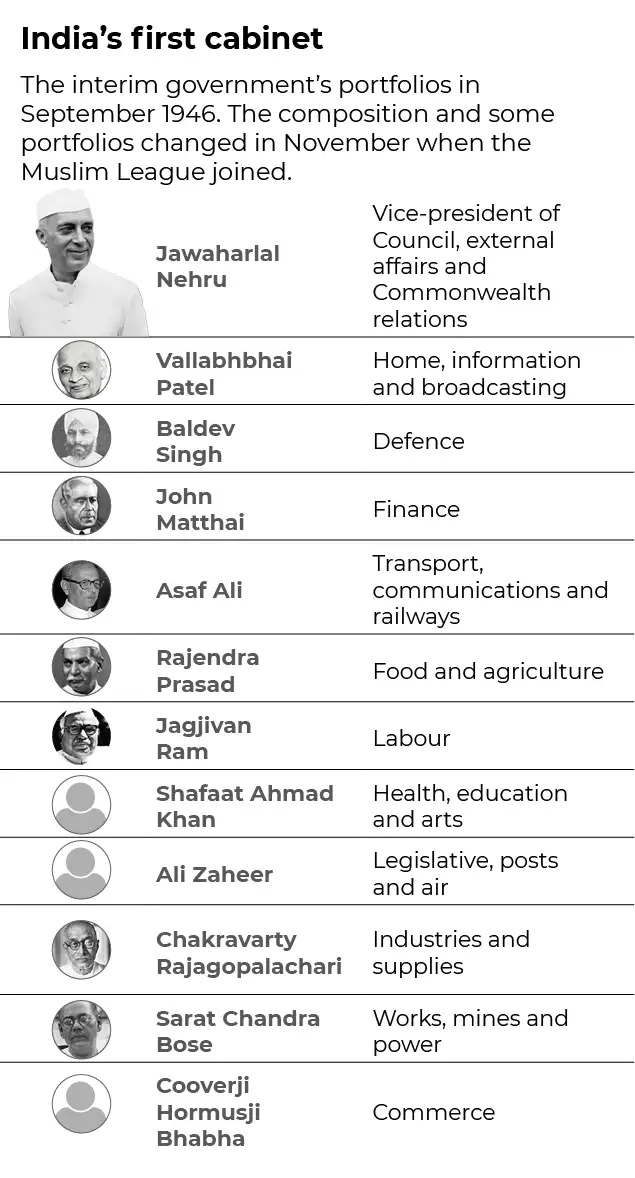
From: Amitava Sanyal, June 22, 2022: The Times of India
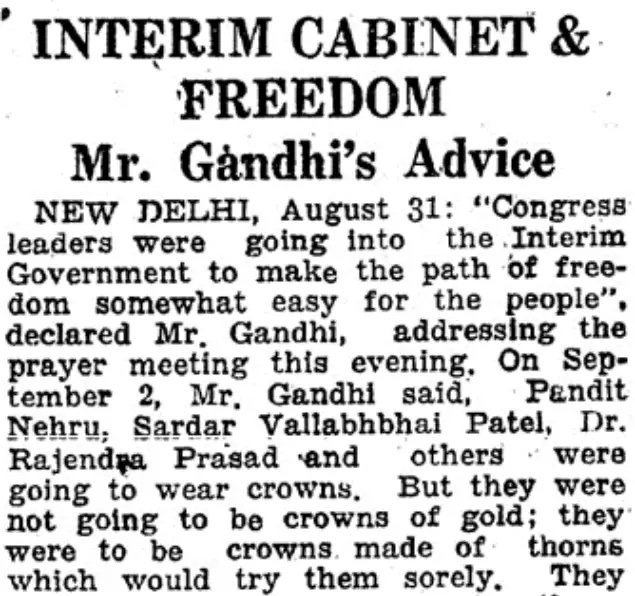
From: Amitava Sanyal, June 22, 2022: The Times of India
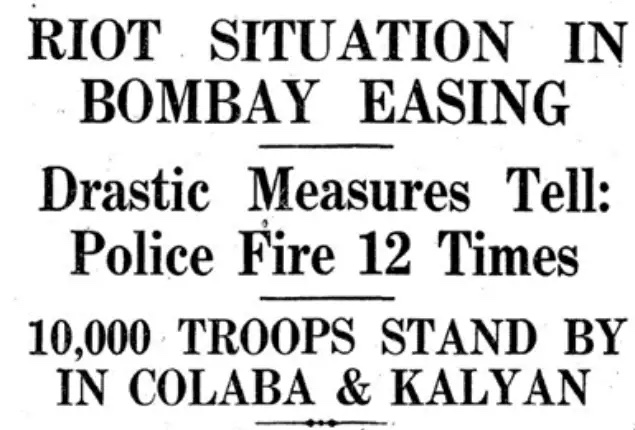
From: Amitava Sanyal, June 22, 2022: The Times of India
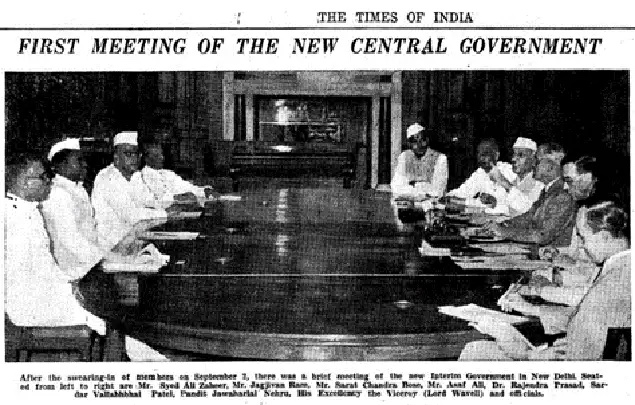
From: Amitava Sanyal, June 22, 2022: The Times of India

From: Amitava Sanyal, June 22, 2022: The Times of India
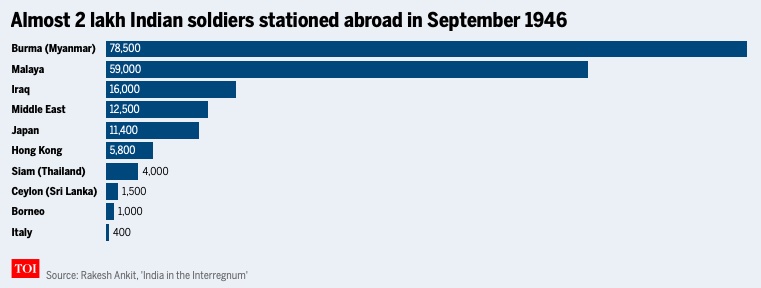
From: Amitava Sanyal, June 22, 2022: The Times of India
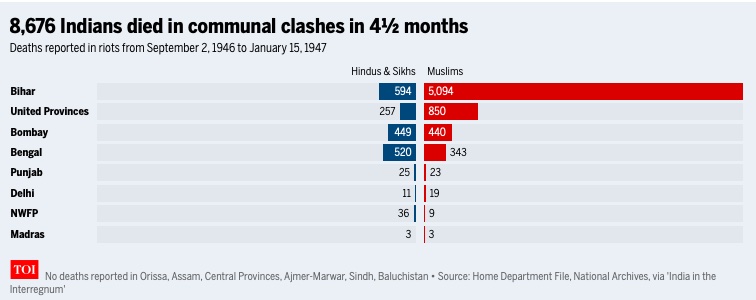
From: Amitava Sanyal, June 22, 2022: The Times of India
It was certain that the Congress and the Muslim League, which had swept the provincial elections in January 1946, would form an interim government and negotiate the transfer.
What wasn’t clear in July 1946 was how the interim government would be formed. The British government’s three-member Cabinet Mission had come in March to negotiate it and been sent back empty-handed. The League was playing hard to get. And it wasn’t clear what powers the government would have.
The Congress, which had formed governments in eight of the 11 provinces, took the lead at viceroy Archibald Wavell’s request. After a series of consultations, Nehru sent a list of portfolios to Wavell on September 1.
Chakravarty Rajagopalachari refused the finance portfolio because of its “heavy responsibility”, writes Rakesh Ankit in his book India in the Interregnum . Then Nehru and Abul Kalam Azad brought in the London School of Economics – and Oxford-trained professor John Mathai.
Mathai, along with steel baron Baldev Singh and insurance magnate Cooverji Bhabha were the non-Congress members of the first cabinet.
Gandhi calls it “a crown of thorns”
The day after the swearing-in was a Monday, which Gandhi had observed with total silence every week for years. So when Sardar Patel, Rajendra Prasad, Jagjivan Ram and Sarat Bose went to meet him after attending a puja at the Birla House in Delhi, he wrote them a short note asking them to work for Hindu-Muslim unity and removal of untouchability.
The country was split in welcoming the decision – Hindus celebrated everywhere but Muslims mourned the League’s absence.
A TOI report said, "Connaught Place was a blaze of tricolours, though here and there a few black flags were to be seen."
Maharashtra politician NV Gadgil proclaimed, "Raisina has fallen." Congratulations poured in from all over the world.
Meanwhile, Bombay continued to burn from the communal fire that had been lit by the Muslim League in Kolkata on August 16, which they called ‘Direct Action Day’.
TOI September 2, 1946 edition: By September, more than 70 had been killed in Bombay, most of them from knife wounds. Curfew was extended in the affected areas
Nehru as ‘vice-president’, crises on many fronts
The first question was what to call the new government. The Congress wanted to call it the ‘provisional national government’ but had no objection to ‘interim government’. But it surely didn’t want the tag of the governor-general’s executive council, which is what Wavell had in mind. There was confusion on Nehru’s designation too. Some reports called him the premier. A radio broadcast and some TOI reports referred to him as chief minister. Finally, Nehru told Wavell that he expected to be nominated vice-president and intended to act as Leader of the House in the Constituent Assembly.
The government leapt into the thick of things on September 5. The first few items at hand were freeing the Indian National Army soldiers captured by the British, dealing with the food crisis, and dousing the communal flames.
The council slowly became a cabinet. Department secretaries no longer had direct access to the viceroy, they had to go through the ministers. The ministers met at Nehru's office every afternoon to discuss policy.
Ankit writes that at the meetings Nehru was "eloquent" on calling back Indian troops, but "glum" on the food shortage. Rajagopalachari and Asaf Ali were “loquacious” on technical details.
Inflation, shortages and labour troubles
The foundation of most of India’s government departments were set in the months that followed.
Jagjivan Ram worked on resettlement of soldiers and labour unrests. Mathai, whom Wavell considered “the most capable and intelligent of ministers”, grappled with inflation and prepared an Anti-Corruption Bill.
Nehru and Azad launched a scheme to send more than 200 Indian students to the US and UK on government scholarships so that they could come back and work for the new nation.
Rajendra Prasad ensured that India staved off a famine. Bhabha laid the foundation of long-term industrialisation, trade reciprocity and a commercial intelligence service.
As the ministers tried to focus on their jobs, Bengal, Bihar and Bombay continued to burn.
Muslim League joins, Liaqat Ali gets finance
When the League finally decided to join in October, wrangling ensued on rejigging the portfolios. Jinnah suggested that the home ministry be given to the League, but Nehru put his foot down and ensured that Patel stayed on.
Oxford-trained lawyer Liaquat Ali Khan came in as finance minister, at number two above Patel. Ibrahim Chundrigar took charge of commerce, Abdur Rab Nishtar as the number six in charge of posts and air, above Asaf Ali and Rajagopalachari (who was shifted to education and arts, making space for Mathai in industries and supplies). Ghazanfar Ali Khan was given health.
Members of the reconstituted interim government that took charge in November 1946: (Front row, L to R) Baldev Singh, John Mathai, C Rajagopalachari, Jawaharlal Nehru, Liaqat Ali Khan, Vallabhbhai Patel, Ibrahim Chundrigar, Asaf Ali and Cooverji Bhabha. (Back row) Jagjivan Ram, Ghazanfar Ali Khan, Rajendra Prasad and Abdur Rab Nishtar.
Meanwhile, Prasad’s schemes of conserving resources, intensifying procurement and rationing food pushed back famine for six months – importantly without imports. The American Famine Commission, visiting India at the time, praised his exemplary work. Nehru and Liaquat put their heads together on releasing the INA soldiers, withdrawing British troops, and setting up Damodar Valley and other power projects.
A budget that blew the goodwill
The interim government began to unravel on February 1, 1947, when the League rejected the Constituent Assembly, which had been set up in December 1946. Then came British Prime Minister Clement Attlee’s announcement on February 20 of Britain’s withdrawal by June 1948 and the appointment of Louis Mountbatten as the new viceroy.
The last nail was a fight over the budget. Deliberations began warmly enough. Liaqat and Wavell consulted Mathai and Nehru before letting the rest of the cabinet in. Mathai recalled, “Wavell came straight from a game of golf, wearing the jacket.”
To meet the growing deficit, Liaqat proposed a business profit tax, an increase in corporation tax, a dividend tax and a capital gains tax. He also suggested a tribunal to deal with tax evasion.
But a week after the budget was presented, Nehru, Patel and Bhabha sent a dissent note saying they hadn't agreed to all the proposals at the meeting earlier. Allegations flew both ways, with Nehru being accused of siding with “Hindu industrialists” who would have to cough up the most in taxes. The air hung heavy when Mountbatten took charge in late March. He held a series of meetings on consecutive days, but his focus was riveted on the coming partition and cabinet affairs moved slower. When the partition plan was announced on June 2-3, Mountbatten formally proposed a “standstill” – to hold off on decisions until the partition was finalised.
Historians have used colourful phrases to play down the interim government’s work – from a government of “pride and prejudice” to “an impossible collective”. What’s certain is that it set the die in which the nation would be cast.